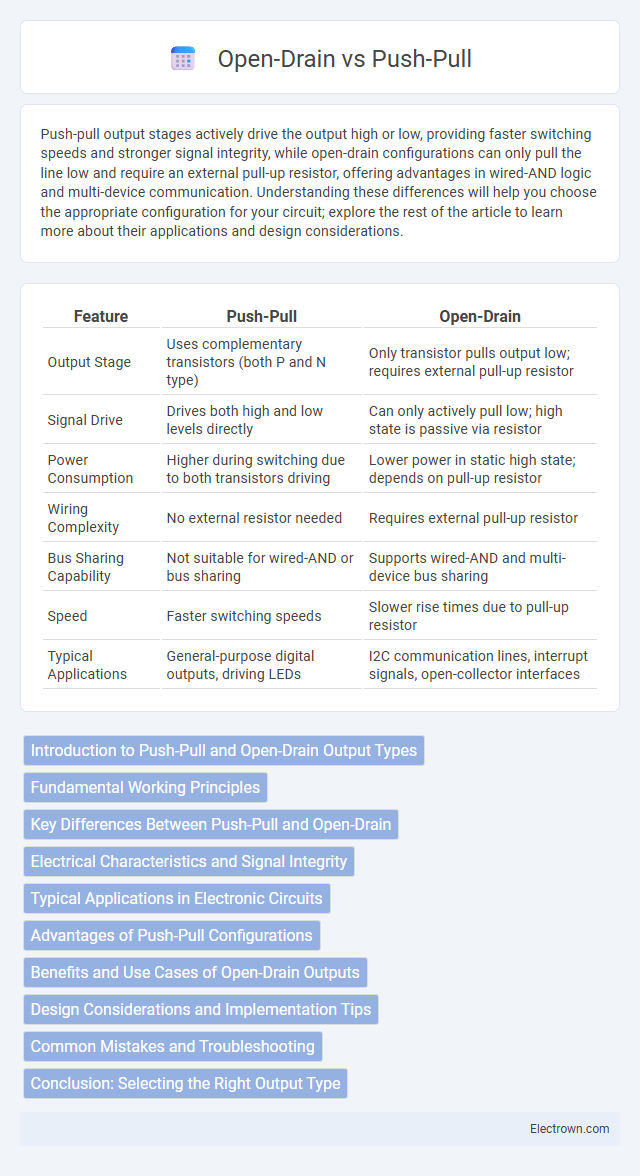Push-pull output stages actively drive the output high or low, providing faster switching speeds and stronger signal integrity, while open-drain configurations can only pull the line low and require an external pull-up resistor, offering advantages in wired-AND logic and multi-device communication. Understanding these differences will help you choose the appropriate configuration for your circuit; explore the rest of the article to learn more about their applications and design considerations.
Table of Comparison
| Feature | Push-Pull | Open-Drain |
|---|---|---|
| Output Stage | Uses complementary transistors (both P and N type) | Only transistor pulls output low; requires external pull-up resistor |
| Signal Drive | Drives both high and low levels directly | Can only actively pull low; high state is passive via resistor |
| Power Consumption | Higher during switching due to both transistors driving | Lower power in static high state; depends on pull-up resistor |
| Wiring Complexity | No external resistor needed | Requires external pull-up resistor |
| Bus Sharing Capability | Not suitable for wired-AND or bus sharing | Supports wired-AND and multi-device bus sharing |
| Speed | Faster switching speeds | Slower rise times due to pull-up resistor |
| Typical Applications | General-purpose digital outputs, driving LEDs | I2C communication lines, interrupt signals, open-collector interfaces |
Introduction to Push-Pull and Open-Drain Output Types
Push-pull and open-drain are common output configurations in digital electronics, each serving distinct purposes. Push-pull outputs actively drive the output both high and low, providing strong, fast signal transitions ideal for driving loads directly. Open-drain outputs can only pull the signal low and rely on external pull-up resistors to achieve a high state, allowing for wired-AND logic and multiple devices to share a common line without contention.
Fundamental Working Principles
Push-pull output stages actively drive the output both high and low by using two transistors, ensuring fast switching and strong drive capability. Open-drain (or open-collector) outputs can only pull the line low and rely on an external pull-up resistor to achieve a high level, enabling multiple devices to share the line without conflict. The fundamental difference lies in push-pull's ability to source and sink current directly, while open-drain only sinks current and requires external components for voltage level restoration.
Key Differences Between Push-Pull and Open-Drain
Push-Pull and Open-Drain configurations differ primarily in their output stages: Push-Pull uses two transistors to actively drive the line high or low, enabling faster switching speeds and stronger signal integrity. Open-Drain outputs rely on a single transistor to pull the line low, requiring an external pull-up resistor to achieve a high state, which provides greater flexibility for wired-AND logic and multi-device bus sharing. Understanding these key differences helps you choose the appropriate output type based on speed requirements, bus complexity, and power consumption.
Electrical Characteristics and Signal Integrity
Push-pull outputs actively drive both high and low voltage levels, providing low output impedance, faster rise and fall times, and improved signal integrity by minimizing voltage overshoot and undershoot. Open-drain configurations can only pull the line low, relying on external pull-up resistors for high-level signals, resulting in slower transitions and potential signal degradation due to increased noise susceptibility and voltage rise time. Electrical characteristics of push-pull allow stronger drive capability and better noise immunity, whereas open-drain offers flexibility for wired-AND connections but sacrifices signal speed and integrity.
Typical Applications in Electronic Circuits
Push-pull outputs are typically used in applications requiring fast switching and strong drive capability, such as microcontroller GPIO pins, LED drivers, and digital logic circuits. Open-drain outputs excel in wired-AND configurations, allowing multiple devices to share a communication line in I2C buses, interrupt lines, and fault signaling systems. Understanding your circuit's needs for speed, power consumption, and signal integrity helps determine whether push-pull or open-drain configuration is optimal.
Advantages of Push-Pull Configurations
Push-pull configurations offer faster switching speeds and improved signal integrity by actively driving both high and low output states, minimizing noise and voltage drop. They provide stronger drive capability, making them ideal for high-frequency digital circuits requiring precise timing and reduced electromagnetic interference (EMI). This configuration also consumes less power during switching transitions compared to open-drain setups, enhancing overall energy efficiency in embedded systems.
Benefits and Use Cases of Open-Drain Outputs
Open-drain outputs excel in applications requiring multiple devices to share a single communication line, such as I2C bus systems, by allowing wired-AND configurations that prevent signal contention. They offer the ability to interface with different supply voltages safely, making them ideal for level shifting and alert signaling in mixed-voltage environments. Open-drain outputs also simplify fault detection and facilitate external pull-up resistor customization, enhancing flexibility and reliability in embedded system designs.
Design Considerations and Implementation Tips
Push-pull outputs provide faster switching speeds and are ideal for driving signals requiring strong high and low states, while open-drain outputs offer flexibility for wired-AND configurations and allow multiple devices to share a line safely. When designing with push-pull, ensure proper voltage levels and consider the risk of short circuits caused by simultaneous drive to opposite states. For open-drain circuits, use appropriate pull-up resistors to define the high state and carefully calculate resistor values to balance speed and power consumption.
Common Mistakes and Troubleshooting
Common mistakes with push-pull and open-drain configurations include incorrect wiring that causes short circuits or improper voltage levels, often due to misunderstanding their output structures. Troubleshooting typically involves verifying the pull-up resistor presence in open-drain setups and ensuring push-pull gates do not drive opposing voltages simultaneously. Checking signal integrity with oscilloscopes and confirming device datasheet specifications can prevent damage and ensure correct operation.
Conclusion: Selecting the Right Output Type
Choosing between push-pull and open-drain output types depends on your circuit's voltage levels and required signal integrity. Push-pull outputs provide faster switching and stronger drive capabilities for standard logic levels, while open-drain outputs allow multiple devices to share a line with customizable pull-up voltages. Your selection should prioritize compatibility with the system's voltage requirements and the need for wired-AND configurations or level shifting.
Push-Pull vs Open-Drain Infographic

 electrown.com
electrown.com